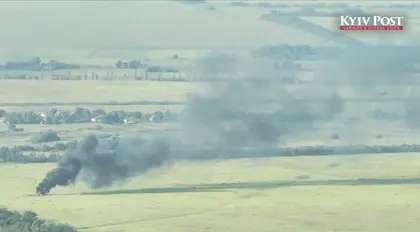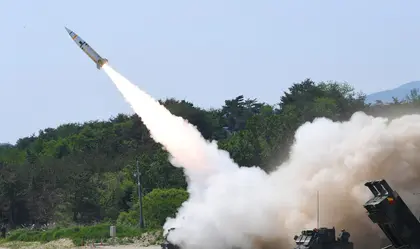Ukraine’s Armed Forces scored two significant successes on Thursday morning, taking out two of Russia’s “Alligator” Ka-52 helicopter gunships.
Soldiers from the 47th Separate Mechanized Brigade reported the downing of one in the vicinity of Robotyne in the Zaporizhzhia region, the aftermath of which was captured on video exclusively obtained by Kyiv Post.
The 47th’s post on Facebook reads: “At approximately 07:40, the fire group of the anti-aircraft missile and artillery division identified an adversary 'Alligator.'
“A single MANPAD launch resulted in the successful destruction of the target.”
In the video obtained by Kyiv Post, two other Russian helicopters approach the scene of the downed Ka-52.
One of them lands and troops disembark before heading for the crashed helicopter.
Elsewhere, Mykola Oleshchuk, the commander of the Air Force of the Armed Forces of Ukraine, reported another Ka-52 “was destroyed in Bakhmut direction this morning.”
He added: “I thank a unit of anti-aircraft missile forces of the Air Force for the successful combat work.”
In its most recent update published last month, the independent monitoring group Oryx – which only counts losses confirmed through open sources – reported that the Russian military had lost 101 helicopters since February 2022 including 87 destroyed, 12 damaged and one captured by Ukrainian forces.

ISW Russian Offensive Campaign Assessment, July 25, 2024
The latest shootdowns – if confirmed – would take the total to 103, 42 of them the Ka-52.
It’s less than two weeks since the last Alligator was shot down after Kyiv’s forces took out the 40th near Robotyne on Monday, Aug. 7
The Kamaz Ka-52 Alligator is considered by military experts as one of the best attack helicopters in the world due to its counter-rotating rotors, “smart” targeting systems, thick armor and powerful armament.
It has a crew of two and one unit is priced at around $10 million. A heavily-advertised feature of the aircraft is the Vikhr attack missile, a weapon Moscow claims can destroy any tank at a 10 km. range, enabling Ka-52 gunners to pick off targets well outside the reach of most Ukrainian air defense weapons.
At least some of Ukraine’s counteroffensive equipment losses are believed to have been inflicted by Ka-52s hovering over the battlefield and firing rockets, according to Forbes.
Despite what the number of downed Ka-52s downed might suggest, the aircraft is an incredibly sturdy piece of kit – a video shot somewhere over Ukraine in June showed one flying back to base missing a big chunk of its tail.
Russians are building flying tanks.
— Trollstoy (@Trollstoy88) June 19, 2023
Ka-52 continues to fly nonchalantly even with a broken tail.
Any other helicopter without a tail rotor is not capable of a similar level of survivability with this kind of damage. pic.twitter.com/Se8Xje1qVi
That hasn’t stopped Ukraine’s armed forces taking them out in droves, though their fortunes have not been plain sailing.
The AFU have since Russia’s late Feb. 2022 invasion used a mix of Soviet-era vehicle-mounted anti-aircraft weapons, and hand-held anti-aircraft missiles donated by Kyiv’s Western allies, to battle the Kremlin’s powerful attack helicopter fleet.
By Apr. 2023 Ukrainian officials were openly warning of falling stocks of hand-held anti-aircraft missiles like the shoulder-fired Igla and said Russian helicopter gunships could soon be operating above battlefields with near-impunity.
Stocks of the default NATO hand-held anti-aircraft missile, the US-made Stinger, are reportedly at critically low levels following more than a year of deliveries to Ukraine and limited production in the US.
The Latvian military, by late April, had emptied its entire stockpile and transferred all its Stingers to Ukraine.
One stopgap measure was a Canadian decision in late May to hand over to Ukraine 43 AIM-9 missiles, a tested anti-aircraft weapon developed by the US.
The Norway-US-manufactured NASAMS ground-based launch system can fire AIM-9 as well and, according to open sources, Ukraine currently operates two NASAMS systems, one donated by the US and the other by Canada.
The AIM-9 Sidewinder missile is widely used in NATO air forces. Its maximum range, per open sources, is above 30 kilometers: about three times the range of the Ka-52’s long-range anti-tank missile. The location of NASAMS systems known to be in Ukraine is a military secret.
Putin’s bungled full-scale invasion of Ukraine also hit helicopter pilots particularly hard. The Royal United Services Institute (RUSI) in London, a military think tank, has said that “the best Ka-52 crews got shot down early in the war while trying to penetrate deep behind Ukrainian lines.”
It added: “Now less-skilled crews are easy targets for ever bolder Ukrainian air defenders… The loss of experienced crews might sting more than the airframe write-offs do. It could take years for the air force to train good replacements for all the Ka-52 fliers who’ve died in Ukraine.”
Ukraine’s 36th Marine Brigade published a colorful account in June, reportedly taking place after a Ka-52 pilot flew too close to Ukrainian lines, and a Marine gunner with callsign “Lyto” hit it with a shoulder-launched, short-range Igla missile.
“The pilot of the Russian helicopter… was moving… at an altitude of less than twenty meters, and the distance to the Ukrainian positions was more than four kilometers… so ‘Putin's vulture’ felt almost invulnerable...
“The missile fired from the Igla MANPADS hit the tail projection of the helicopter. Later, ‘Lyto’ and his brothers watched a picturesque picture: the vaunted analog-propellant ‘Alligator, leaving behind a trail of greasy thick smoke, began to sharply lose [altitude] and disappeared from sight in a few seconds,” the after-action report published on the brigade Telegram channel on June 18 said.
You can also highlight the text and press Ctrl + Enter






